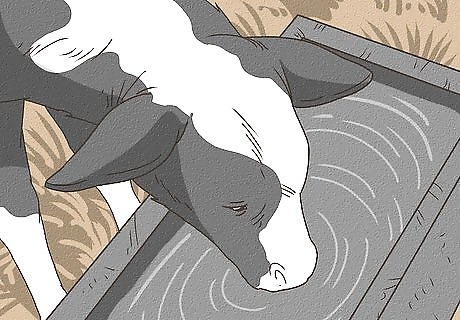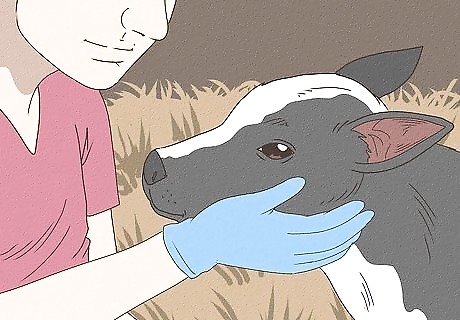
views

Place the calf in a warm, safe and secure area. Any place that provides shelter for the calf away from inclement weather or other animals will be sufficient. A barn with a small pen inside is sufficient. A calf hutch, be it bought or made, is also good for the calf. The fence should be enough so the calf cannot escape should he decide to wander away for a little bit. Make sure you pack the ground with straw for the calf to sleep on (applicable to those who calve in the winter or early spring). Do not simply put a calf in a barn without any sort of bedding. Calves are much more susceptible to cold than cows are, and a thick bed of straw will keep the calf nice and warm. For those calves born in the summer, he should have an area where he will be shaded from the sun for most of the day. However, calves also need their Vitamin D, so don't devoid him completely of any access to any sunny areas the calf might like to sleep in.

Buy proper nursing and feeding supplies as soon as possible. Colostrum should be priority and should be on-hand before you get any other supplies. Powdered colostrum can be obtained at a local feed store or your local large animal veterinarian. You must feed the calf colostrum within 24 to 72 hours after birth. Any time after and the calf is more subject to illnesses and diseases that could easily kill it. Colostrum needs to be fed once every 2 to 3 hours. Depending on the weight of the calf, you need to feed one or two quarts per feeding. If the calf will not take the bottle right away, then you will have to use an esophageal feeder to feed the calf, especially if it is weak from the cold or from a difficult birth. If the young calf is hungry, it will accept the bottle right away, especially if you give it a taste of milk by rubbing milk formula over its nose and in its mouth. Young calves that haven't been suckling at their dams are the quickest learners. Older calves are much harder to get to accept the bottle because they have become accustomed to suckling from their mothers.

Bottle or bucket-feed the calf every two to three hours until it is a few days old. Between that time you can slowly change the milk formula from colostrum to normal calf-milk formula. After that you can start feeding the calf three times a day: morning, noon and night. Make sure you give the calf 10% of his body weight in milk per day. As the calf gets older, the number of feedings per day can start to decrease. Decrease to twice a day when the calf reaches a month old, then once a day when the calf reaches a little over 2 months old. Bottle calves are typically weaned from the bottle by the time they are 3 to 4 months old.

Offer clean fresh water to the calf at all times. Keep a bucket available that the calf cannot turn over. Calves are always curious, and they soon figure out that that clear liquid stuff in the pail is good to drink.

Feed the calf a ration of high-quality calf feeds. Special formulated calf-starter diets can be purchased at your local feed store, and are good to get a calf started on to help him grow. These feeds are high in protein, calcium, phosphorus, energy and other important nutrients that he needs for growth. Also let the calf have access to high-quality hay. Make sure you feed-test the hay to ensure it is the high quality that it looks, because quite often hay that looks like is good is mere gut-filler, even if it is green. The hay should be 60% legume (alfalfa or clover) and 40% grass.

Talk to a vet about what sort of vaccinations and vitamin/mineral injections are needed for the calf. Depending on the health and age of the calf and where you are located, certain injections that a newborn needs include Vitamin A, D and E, Selenium (only for Selenium-deficient areas!), etc. More vaccinations will be needed if you did not vaccinate your cows for illnesses such as scours, or if you did not feed the calf the colostrum from his mother. Certain vaccinations need to be done when the calf is 2 to 3 months of age, which also often require boosters.

Keep the area where the calf is clean. Replace soiled straw every day with fresh straw, and use a fork and shovel (or one of those forks specially designed for mucking out horse's stables) to remove any feces or soiled straw. Also check to see if any "accidents" were made in the calf's feed area, and remove any soiled feed if you see any.

Watch the calf closely for any signs of illness. If your calf develops scours (calf diarrhea), infection (i.e., joint ill or navel ill), respiratory problems, or anything that seems out of the ordinary, call a vet. It's easy to over-react when you hear your calf cough for some reason or other. Sometimes coughing or sneezing comes from a little bit of feed it got caught in its throat or he inhaled too much dust or feed by accident. If the coughing or sneezing is not regular, then it is nothing to worry about. If he's coughing all the time and develops other symptoms, then it's time to call the vet. Not keeping regular scheduled feedings will cause a calf's stomach to get upset and make him get scours. Keeping a routine will prevent this. Check the calf for ticks, fleas, lice and other bugs that can spread disease. Spray to alleviate flies and mosquitoes as well.

Keep up with feeding, nursing and caring for the calf, and soon it will be time to wean him and watch him grow into a healthy bovine!



















Comments
0 comment